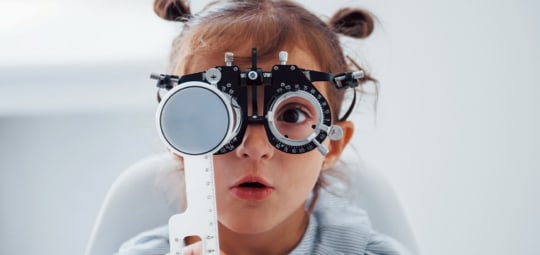Myopia, hyperopia, and astigmatism are refractive errors. Myopia results in blurry distant vision, hyperopia results in blurry near vision, and astigmatism results in selective blurry vision at all distances.
Regular eye exams are crucial for monitoring eye health and early detection and management of these vision conditions so they don’t progress.
What Is a Refractive Error?
With a normal-shaped eye, when light enters, it refracts or bends and focuses on the retina (the light-sensitive tissue at the back of the eye), resulting in a clear image. However, in a refractive error, an irregular-shaped eye prevents light from focusing directly on the retina, leading to blurry vision.
What Is Myopia?
Myopia, also known as nearsightedness, is when you can see objects up close clearly, but distant objects appear blurry. This condition occurs when the eyeball is too long or the cornea is too curved, causing light to focus in front of the retina. Your risk of developing myopia is higher if a family member is myopic.
What Is Hyperopia?
Hyperopia, or farsightedness, is the opposite of myopia. If you have hyperopia, you can see distant objects clearly but struggle with close-up vision. This happens when the eyeball is too short or the cornea has too little curvature, causing light to focus behind the retina. Children with astigmatism may be at a higher risk of other eye conditions, such as lazy eye.
What Is Astigmatism?
Astigmatism is different from myopia and hyperopia. If you have astigmatism, your cornea or lens is irregularly shaped, leading to distorted or blurred vision at all distances. This irregularity prevents light from focusing properly on the retina, causing vision issues.
Symptoms of Myopia, Hyperopia, & Astigmatism
Common symptoms of myopia include:
- Blurry distant vision
- Frequent squinting
- Eyestrain
- Headaches
- Sore eyes
- Eye fatigue
You might not notice symptoms with mild myopia. However, eye exams can help detect these changes so treatment can provide vision clarity. Myopia can progress to severe myopia, making regular eye exams vital for detecting myopia and starting treatment to prevent the risk of more serious eye diseases later.
Hyperopia symptoms can be subtle and can include:
- Blurry near vision
- Eye strain, especially with prolonged reading or computer use
- Headaches
- Eye fatigue
Astigmatism symptoms can include:
- Blurred or distorted vision
- Difficulty seeing at night
- Eyestrain and headaches
- Squinting to see clearly
Diagnosis: The Importance of Regular Eye Exams
Regular eye exams are your first line of defense against vision problems. Your eye doctor can diagnose myopia, hyperopia, and astigmatism using various tests. These can include:
- Visual acuity test: Measures how you see at multiple distances.
- Refraction test: Determines your exact prescription for glasses or contact lenses.
- Keratometry and topography: Measures the curvature of your cornea to detect astigmatism.
Early diagnosis can help improve your vision, prevent vision from worsening, and prevent complications.

Treatment for Myopia, Hyperopia, & Astigmatism
Glasses are the most common and easiest solution for vision correction. They come in various styles and prescriptions to suit vision needs and fashion preferences. Your eye doctor can recommend the right option whether you need single-vision lenses, bifocals, or progressive lenses.
Contact lenses offer the same vision correction as glasses but with the added benefit of a broader field of view. They are available in various materials and designs, including daily disposables, extended wear, and toric lenses for astigmatism.
For a more permanent solution, surgical options like refractive eye surgery can correct myopia, hyperopia, and astigmatism. These procedures reshape the cornea using a laser, improving how light focuses on the retina.
Lifestyle Changes & Prevention Strategies
While glasses, contacts, and surgery can correct vision issues, lifestyle changes can help prevent these conditions. Here are some tips:
- Regular eye exams: Early detection can make a significant difference.
- Healthy diet: Foods rich in vitamins A, C, and E can support eye health.
- Screen breaks: Follow the 20-20-20 rule—every 20 minutes, look at something 20 feet away for at least 20 seconds.
- Protective eyewear: Use sunglasses to shield your eyes from harmful UV rays.
The Importance of Early Detection & Treatment
Ignoring vision problems can lead to worsening symptoms and complications. Early detection and treatment can improve your quality of life and prevent further issues.
Myopia, for example, can develop in early childhood and progress as children grow. However, myopia control measures can help manage myopia symptoms and prevent myopia progression.
Healthy Long-Term Vision
Myopia, hyperopia, and astigmatism are common vision conditions that can affect individuals of all ages. Each condition has its unique symptoms that cause vision changes.
Regular eye exams can identify these conditions and determine treatment for maintaining good eye health and healthy long-term vision. Don’t wait until your vision changes or worsens to take action. Book an appointment with The Village Eye Care.
















